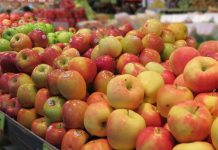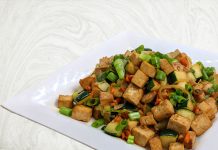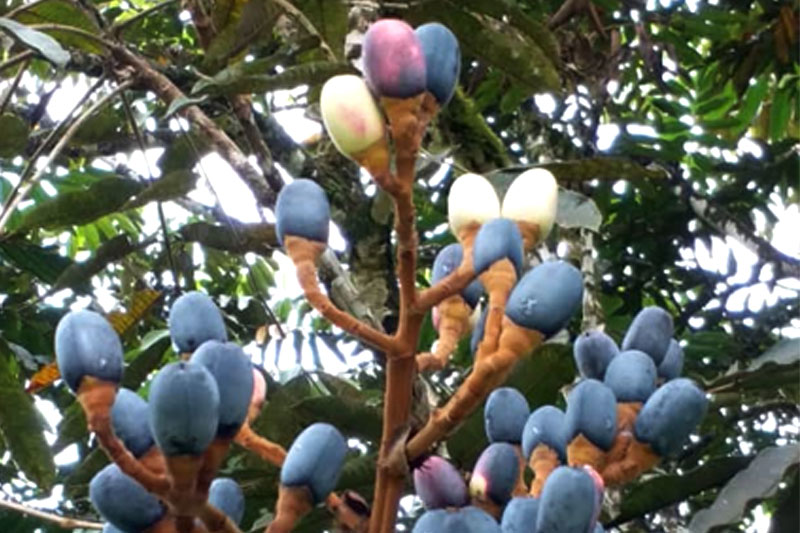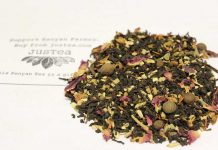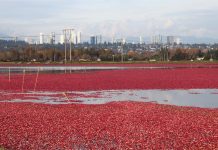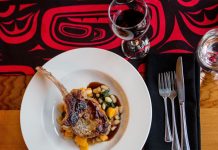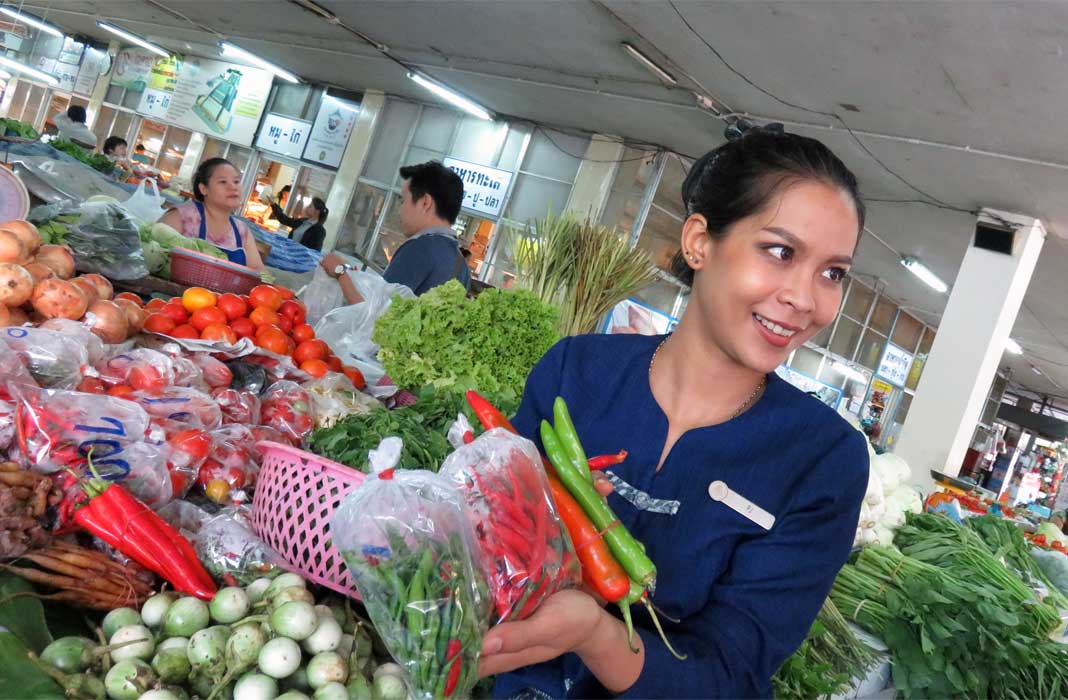Thanin market has long been a place where locals shop. What’s attracting global gourmands to this Chiang Mai market? Discover delicious dishes and bizaare food finds.
The early morning mist turned to drizzle as we drove pass past lush forests and rural communities to Thanin market. Kad Thanin as the locals call it, is about a half hour drive from the Four Seasons Resort Chiang Mai.
Bursting with vibrant colours and heavy with exotic aromas – Thanin market is one of the city’s oldest marketplaces.
Situated on the south gate of Old Chiang Mai city, Thanin is also known by its former name, Siri Wattana.
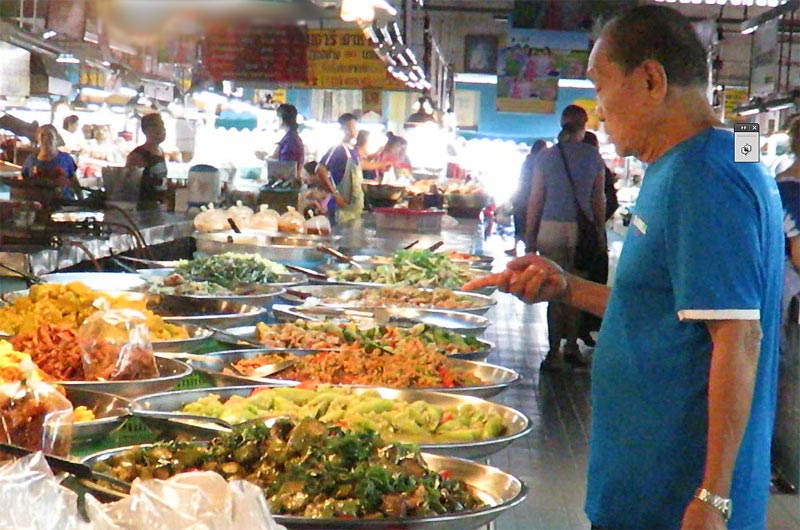
Rich and Diverse Cuisine
Local shoppers source for the day’s freshest ingredients while curious tourists explore the fascinating foodscape.
From condiments, fresh produce to meats, snacks and prepared foods, Thanin reflects the ethnic diversity of Chiang Mai.
The cornocopia of foods reveal strong Burmese, Loatian and Yunnanese influence.
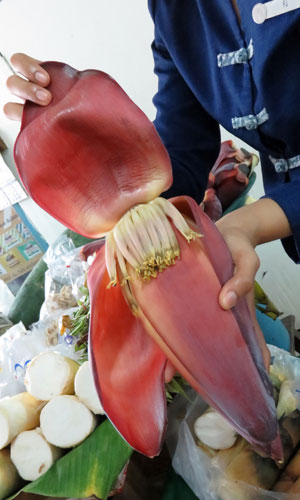
Chiang Mai, Thailand’s second largest province is agriculturally and culturally rich. Chiang Mai city, the provincial capital is northern Thailand’s largest metropolis populated by over 200,000 people.
It is the ancient capital of the once powerful and culturally prosperous Lanna Kingdom.
Chiang Mai city received the 2017 Travel and Leisure World’s Best Awards recently for Asia’s top best city to visit.
Our first stop, the dry goods stall selling fish sauce (nam pla), a key flavouring ingredient in Thai cuisine.
“Fish sauce tastes salty and is made from fermented anchovies,” explained PJ, the resort culinary expert. The amber-coloured liquid adds umami-richness to mundane dishes.
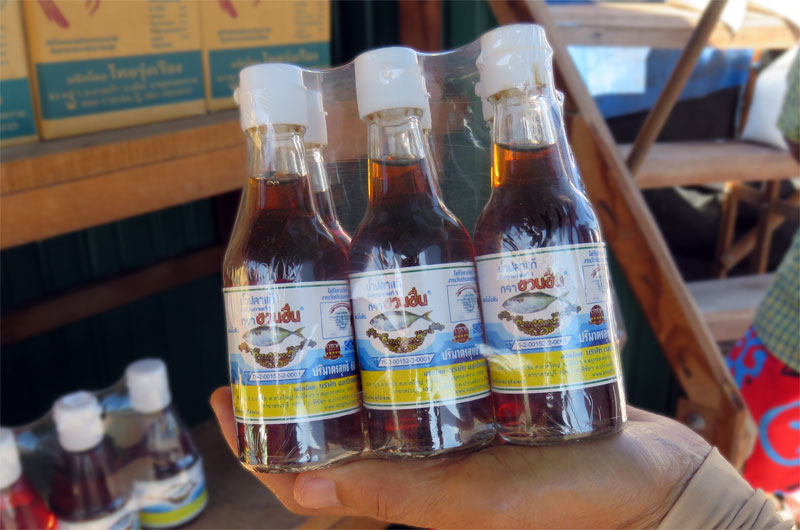
“Vegetarians and non-fish sauce fans can substitute it with soy sauce. Another common Thai condiment is oyster sauce, which is use a lot in stir-fries.
Mushroom sauce can replace oyster sauce for shellfish allergic individuals or vegetarians.”
Meat stalls sell everything from pork, chicken, beef to offals and seafood. Free-range chicken are turmeric-coloured to distinguish them from the regular poultry.
Unique Chiang Mai Dishes
Dried fish, squid and preserved vegetables laid next to trays of pink, white and brown eggs.
We call it ‘horse pee’ eggs…
The pink colour differentiates the regular eggs from the century eggs, said PJ. Pink eggs are duck eggs cured in charcoal, mud or clay for 15 days to one month.
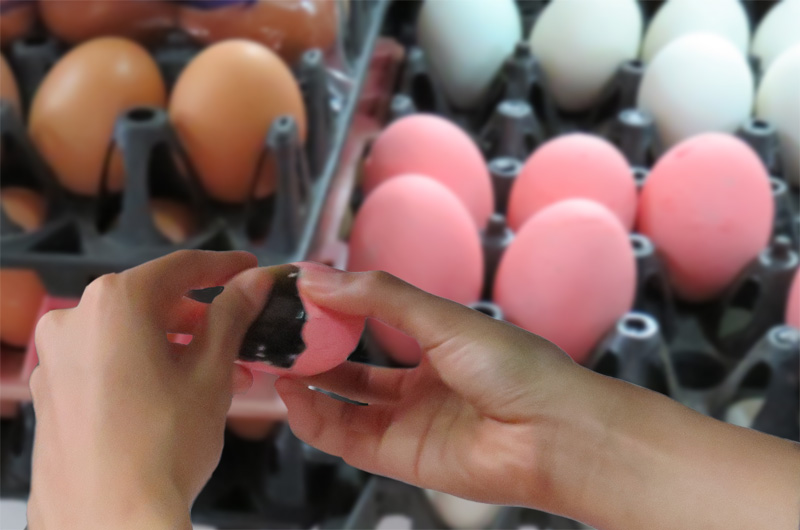
“We call it ‘horse pee’ eggs, and its best eaten with pickled ginger or fry with hot basil,” said PJ cracking an egg to reveal the black, gelatinous albumen.
Thais eat lots of curries, PJ laughed, gesturing her hand to mounds of freshly-grounded red, green and yellow paste.
Chiang Mai’s signature dishes include Khao Soy, noodles in yellow curry – and Sai ua, grilled herb-and-spice-infused pork sausage.
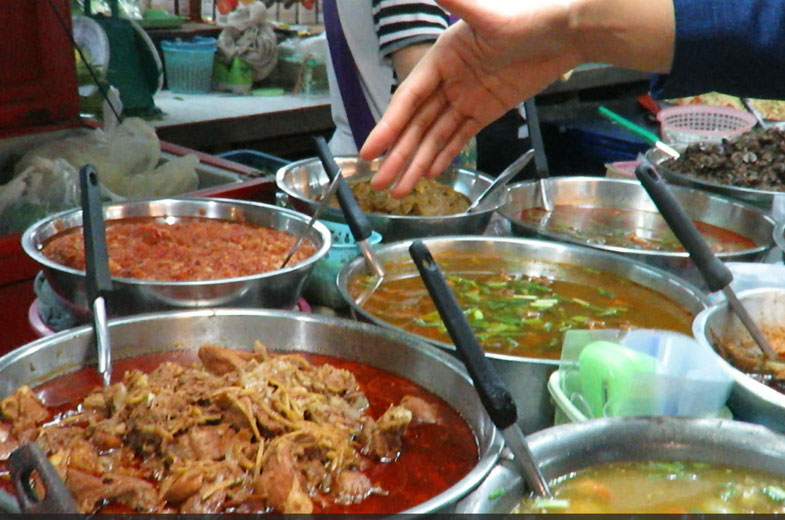
Miang kham, a healthy leaf-wrapped snack meal is shared with family or friends. The betel (thonglang) leaf is fold into a cone, and fill with roasted coconut, shallots, bird-eye chillis, ginger, garlic, lime peel, chopped peanuts and dried shrimp.
Most Thai restaurants around the world offer northern Thai papaya salad on their menus. This refreshing appetizer of shredded green papaya with chillies, herbs, vegetables, lime juice, peanuts and other Thai ingredients is a must-try.
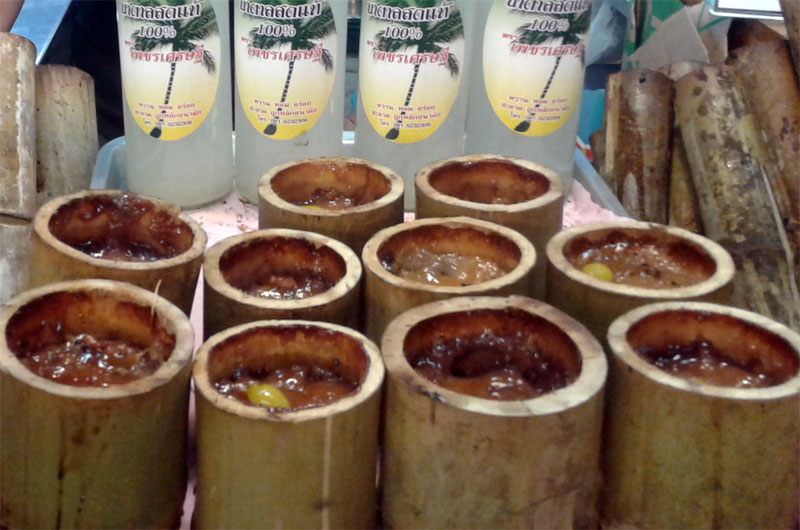
An array of tempting desserts awaits the sweet tooth: mango sticky rice and grilled black rice served on banana leaf.
Exotic Eats for the Adventurous
The prepared food stalls feature exotic eats including spicy whole frog soup, deep-fried water buffalo stomach, and larb Lu. Larb Lu is a raw dish of minced pork or beef mixed with animal blood, kidney, fat and bile – seasoned with spices and herbs.
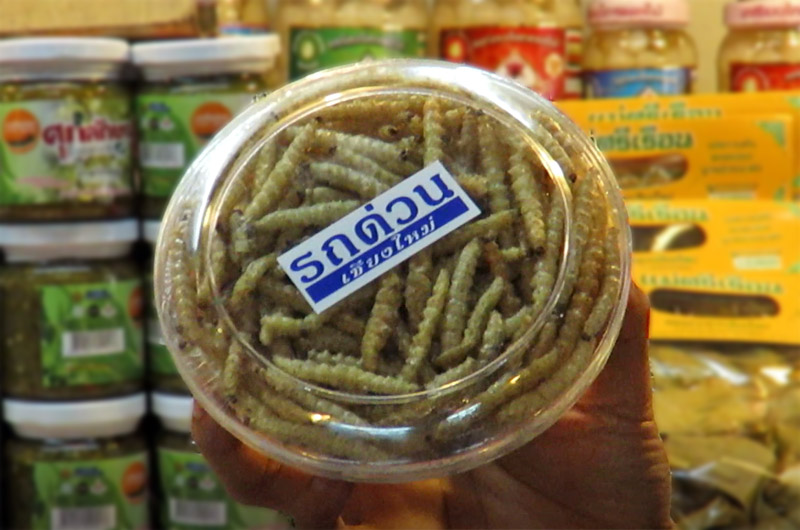
Food items tightly packed on shelves may seem strange to Western eyes but a treat to those who appreciate its flavours. There’s crunchy deep-fried bamboo worms that resemble spiral chips- with a taste liken to French fries.
Beetles, crickets, and shrimp-like tasting grasshoppers are popular munchies.
Bugs are gastronomic delights especially among Northern Thais
In northern Thailand, even pets eat well. At one stall, a vendor chops up deep-fried chicken’s neck and head for sale as gourmet dog treats.
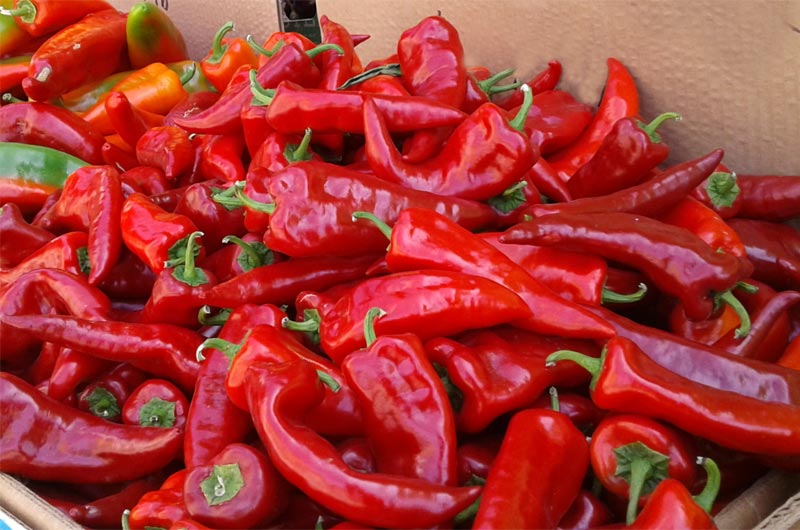
No Chilli, No Cooking
Fresh vegetables, seasonal fruits, aromatic herbs and spices arrive at the market daily from the heartland of Chiang Mai.
Chillis, basils, lemongrass, mints and coriander roots, vie for prime counter spots. There’s even Thai ginseng added to curries for aphrodisiac effects.
Perhaps, the most indispensable Thai ingredient is chillies. “No chillies, no cooking ,” says PJ holding a fistful of bird eye chillies in her hand. Virtually every Thai dish has a dose of the fiery spice to excite the taste buds.
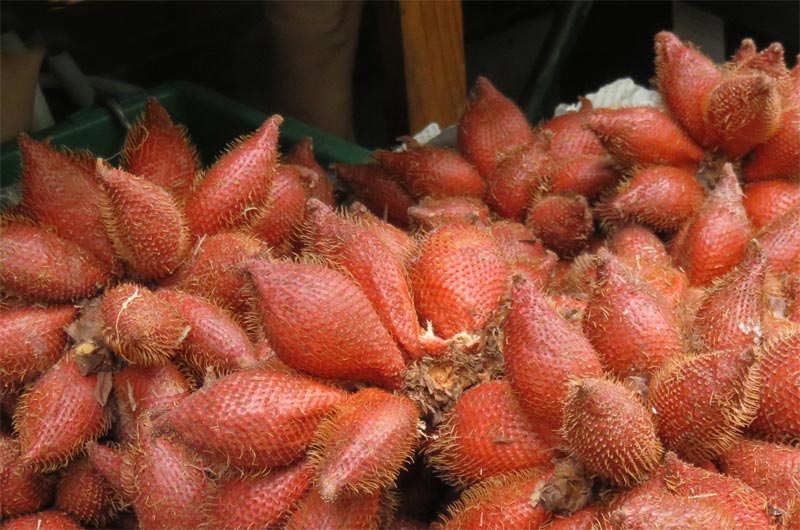
Related: Terraces Restaurant: Each Bite Is a Treat for the Discerning Epicurean
June is fruiting season in Thailand. Shoppers haggle with vendors over prices on the market fringe crammed with candy-tasting durian, mangosteen, mango, jackfruit and different tropical fruits. One of Thailand’s top exports is fresh fruits.
There is so much to see and explore at the market. The delicious foods would have gourmands salivating.
Our hour and a half tour of Thanin market was up. We had to return to the resort for the Rim Tai Kitchen cooking class, a program I look forward to since my arrival at the resort.



